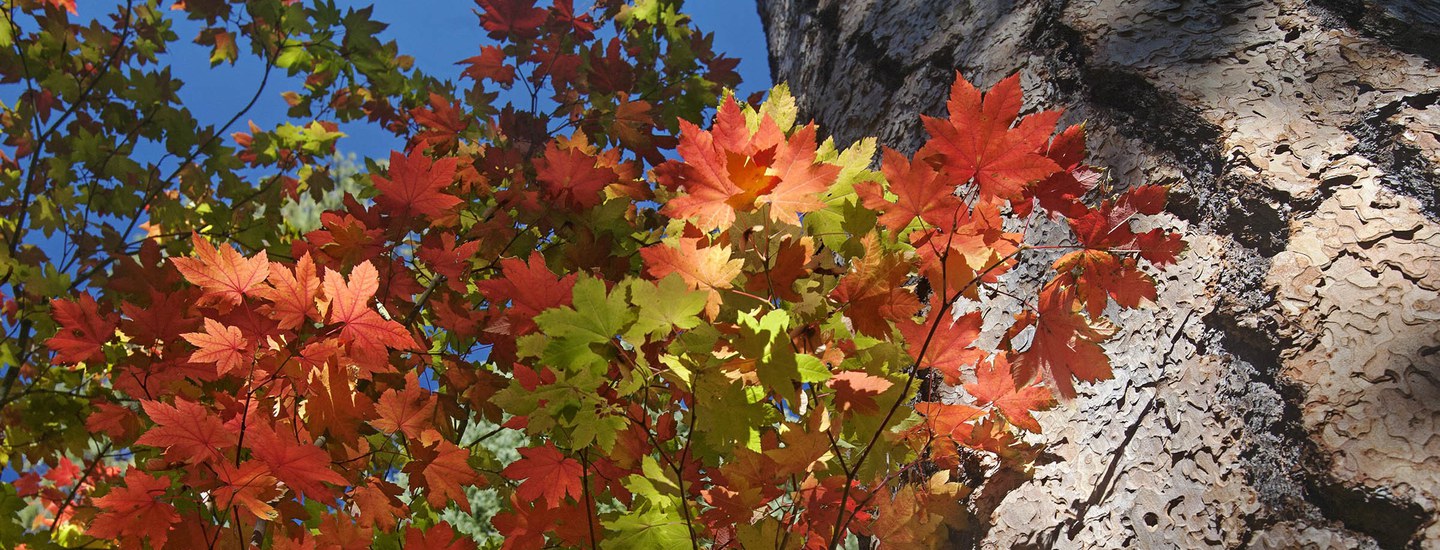With fall officially here, the time has come to head out to catch some seasonal displays of color! Leaf peeping is a pastime for many people who revel in the changing of the seasons and nature’s last burst of color before winter. While Central Oregon’s fall colors may not compete with the glorious sugar maples of Vermont, we have our own little maple that puts on its own stunning show.
The vine maple (Acer circinatum) is a tall, understory shrub native to the Pacific Northwest. You’ve probably seen it driving over the Cascades to the Willamette Valley. It’s bright bursts of red, yellow and orange provide a stark contrast to the green forest or black lava flows. Vine maple is very common on the west side of the Cascades and is found in wet areas growing under other trees where sunlight is filtered. However, it also grows on the east side of the Cascades in drier ponderosa pine forests and even open lava flows where it can find enough water.
Vine maples play an important role in nature. Their roots help keep our rivers and streams clean by keeping banks from eroding and soil from running into the water. Like all plants, they help remove carbon dioxide from the air and store carbon—major plus in the climate change era! Vine maples also have value for wildlife. Their leaves provide important food for deer and elk, small mammals and birds eat the seeds, buds, and flowers, and a variety of animals take cover in their dense thickets. Finally, vine maple is adapted to fire and will re-sprout from its root system after some lower intensity fires.
But why do vine maples have such brilliant fall colors? Their leaves contain pigments that are stored all year long and eventually provide the bright colors we see each fall. There are three main pigments: carotenoids which provide the yellows and oranges, anthocyanins which provide the beautiful reds, and chlorophyll which is the green factory. In the fall, as days get shorter and nights longer, the plant slows down and eventually stops its chlorophyll production. The green gives way to yellow and orange and red. Vine maples have spectacular yellow leaves in more shady locations, and even more stunning orange and reds in sunnier locales!
When will they change color? The biggest trigger for fall color is the calendar. Shorter days and less sunlight trigger the chemical processes that tell vine maples to prepare for winter. Leaves must prepare for winter and drop before freezing temperatures arrive because their sensitive tissues would not survive the cold weather. Of course, weather also plays a role in fall colors. Warm sunny days with crisp nights tend to produce the most brilliant fall colors. Extreme cold or storms can impact timing and color, and, unfortunately, climate change is also impacting our fall colors. Drought can cause leaves to drop before they change color and wildfire can destroy the entire plant.
In Central Oregon, depending on the year, our vine maples begin to change at the end of August at higher elevations and into September at lower elevations. The end of September is often a great time to go leaf peeping! The great news is that you can find them in so many places. Look for them along Lava Island falls in the Deschutes River, up on McKenzie Pass in a lava field, and along our rivers and streams. The Deschutes Land Trust’s Metolius Preserve is a favorite local destination for stunning displays along Lake Creek. Happy leaf peeping!
This story first appeared in the Source Weekly.
Sources:
- The Leaves they are a Changing
- Science of fall colors
- Landscape plants: Acer circinatum
- USFS: Acer circinatum
Learn more:
- Fall colors and where to find them
- Top Places for fall color in Central Oregon
- Suggested routes at Land Trust Preserves


